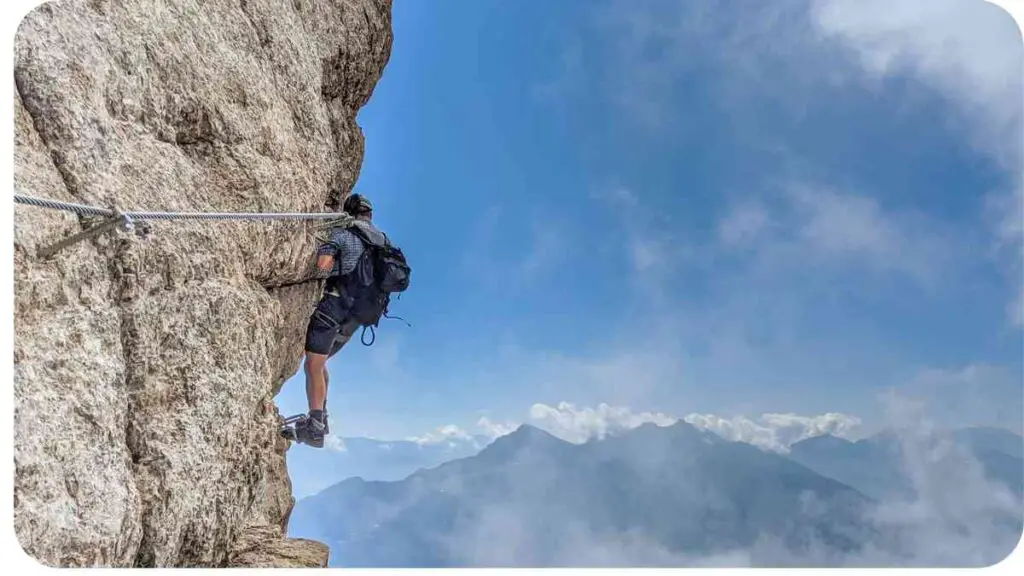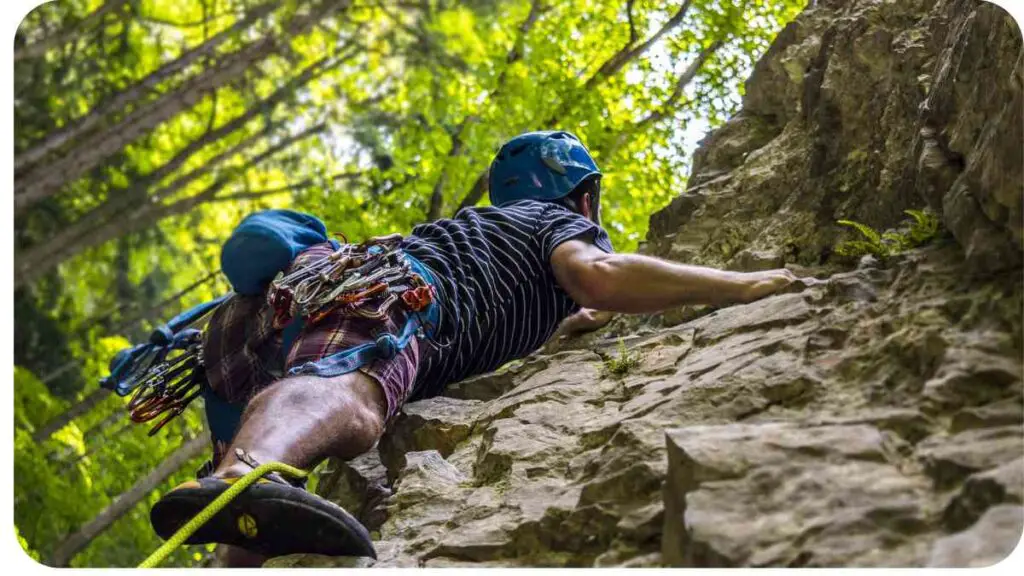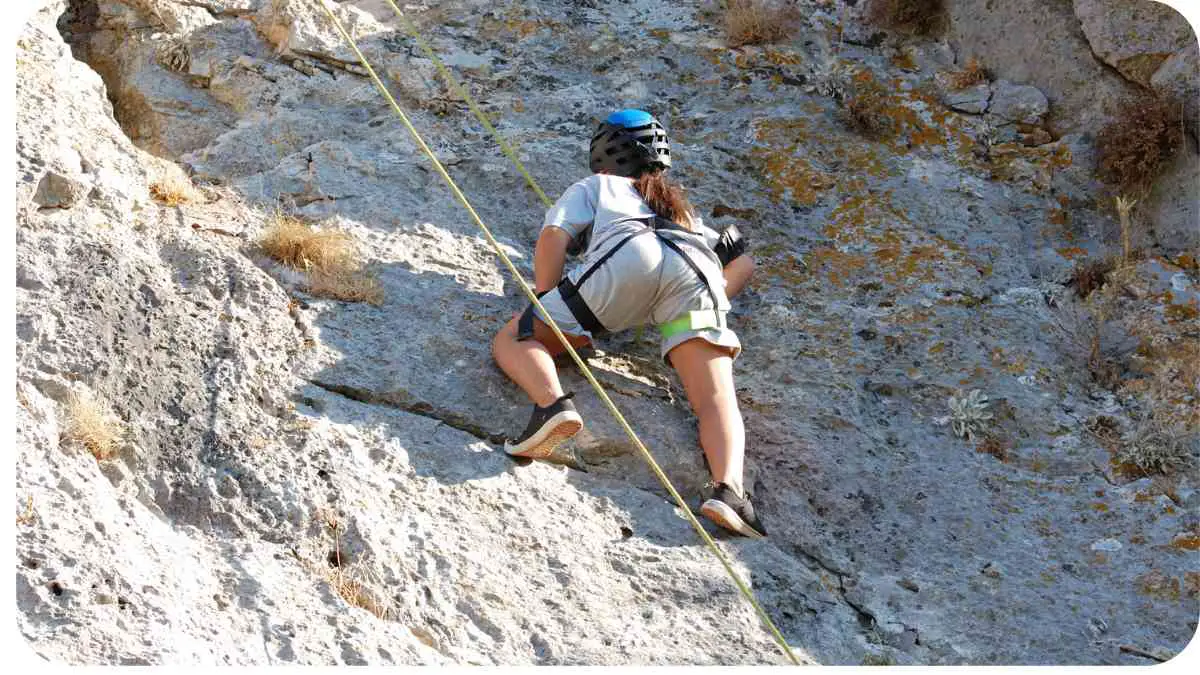If you’re an avid climber, you know the thrill and exhilaration of scaling magnificent rock faces. However, sometimes the climbing experience can be hindered by an irritating yet common phenomenon known as rope drag.
Rope drag occurs when the rope encounters resistance due to friction against the rock or gear, making it harder to move upward smoothly. In this article, we will delve into the causes of rope drag, its impacts, and most importantly, share techniques and strategies to reduce resistance during climbing, ensuring a more enjoyable and efficient ascent.
| Key Points |
|---|
| Gear placement is crucial in preventing rope drag. |
| Extending gear placements with slings or quickdraws can minimize rope drag. |
| Using slings and runners effectively reduces rope drag. |
| Choosing a direct route can substantially reduce rope drag. |
| Proper rope management is essential in minimizing rope drag. |
| Specialized gear options are available to help prevent rope drag. |
2. Understanding Rope Drag
Before we delve into reducing rope drag, let’s grasp the concept itself. Rope drag is the frictional resistance created when the rope rubs against the rock or gear during a climb. The factors contributing to rope drag include the angle of the rope, the placement of gear, the direction of the climb, the length of the rope, and the rock’s texture. Understanding these factors is essential to effectively mitigate rope drag and enjoy a smoother experience on the wall.
When tackling ice climbing, remember that ‘preparation is key’ ultimate guide. This comprehensive resource offers valuable insights into techniques and must-visit spots for a successful climbing experience.
3. Causes of Rope Drag
To tackle rope drag, it’s crucial to identify its causes. Here are some common culprits:
- Tight Angles: When the rope runs at tight angles around corners or edges, it increases friction, leading to rope drag.
- Excessive Gear Placement: Placing too much protection too closely can create a cluster of gear that catches on the rock or one another.
- Zigzagging Routes: Choosing a meandering route that zigzags will increase rope drag due to the increased length of rope running against the rock surface.
- Long Pitch Length: A longer pitch with insufficient gear placements results in significant rope sag, causing drag as the rope spans across the wall.
- Rope Bend: Sharp angles in the rope caused by weight differences in the climbing team or inadequate rope management lead to increased resistance.
4. Impact of Rope Drag on Climbing Performance

Rope drag is more than just an annoyance; it can have a significant impact on your climbing performance. Here’s what you need to know:
- Loss of Energy: When you’re constantly battling rope drag, it takes a toll on your energy reserves, making a difficult climb even more exhausting.
- Reduced Mobility: Drag can restrict your movement, making upward progress slower and more strenuous.
- Increased Risk: Rope drag can increase the chances of gear shifting or dislodging, compromising your safety on the wall.
- Psychological Burden: Dealing with resistance can be demoralizing and drain your mental focus, affecting your overall climbing experience.
To overcome these challenges, let’s explore effective techniques that can help reduce rope drag when climbing.
For beginners in the USA, choosing the ‘right climbing spot’ best spots for beginners is essential. Discovering suitable locations can help minimize resistance and ensure a safe and enjoyable climb.
5. Techniques to Reduce Rope Drag
Reducing rope drag requires a combination of smart tactics, thoughtful gear selection, and careful route planning. Consider the following strategies:
5.1 Choosing the Right Rope
Picking the appropriate rope is paramount in minimizing rope drag. Opt for a thinner and lighter rope that glides more smoothly across the rock surface. Thinner ropes offer less resistance and are less prone to getting caught on features or gear. Additionally, consider using a dry-treated rope, as this reduces friction by repelling water and dirt.
5.2 Minimizing Rope Bend
Excessive rope curvature increases resistance. Minimize rope bend by ensuring proper rope management and avoiding tangles. Stack the rope neatly at belay stances, avoiding knots or twists that could cause friction. When leading a pitch, consider placing gear strategically to reduce sharp bends in the rope.
5.3 Proper Placement of Protection
Strategically placing gear can minimize rope drag. Optimize the distance between gear placements, ensuring they are evenly spaced. By doing so, you distribute the load evenly across the route, reducing rope sag and friction. Take into account the natural features of the rock and select appropriate gear to avoid obstructions or unwanted rope angles.
Table: Recommended Gear Placement
| Pitch Number | Gear Placement | Distance Apart (ft) |
| 1 | Cam #1 | 6 |
| Cam #2 | 8 | |
| Nut #3 | 10 | |
| 2 | Cam #1 | 5 |
| Cam #2 | 8 | |
| Cam #3 | 7 |
5.4 Extending Placements
Extending gear placements using slings or quickdraws can help reduce rope drag. By extending the distance between the protection and the rope, you minimize friction against the rock. This technique is especially useful on wandering routes or those with sharp corners.
Mastering the speed climbing route requires ‘expert guidance’ expert tips. This article shares valuable insights and strategies that can improve your climbing skills and reduce resistance.
Table: Recommended Extended Placements
| Pitch Number | Gear Placement | Extension Length (inches) |
| 1 | Cam #1 | 12 |
| Cam #2 | 16 | |
| Nut #3 | 8 | |
| 2 | Cam #1 | 10 |
| Cam #2 | 14 | |
| Cam #3 | 12 |
5.5 Utilizing Slings and Runners
Using slings and runners effectively can greatly reduce rope drag. By extending the rope’s length between protection points, you create smoother paths for the rope. This allows it to run more freely and encounter less friction against the rock surface.
Table: Recommended Sling/Runner Length
| Pitch Number | Gear Placement | Sling/Runner Length (inches) |
| 1 | Cam #1 | 24 |
| Cam #2 | 30 | |
| Nut #3 | 18 | |
| 2 | Cam #1 | 20 |
| Cam #2 | 26 | |
| Cam #3 | 24 |
5.6 Avoiding Zigzagging Routes
Choosing a direct route rather than a zigzagging one can substantially reduce rope drag. Minimizing the length of rope running against the rock will decrease friction and make for a more streamlined climb. Plan your route carefully, considering the natural features of the wall and the path of least resistance.
5.7 Rope Management
Proper rope management plays a crucial role in minimizing drag. Keep the rope taut and avoid unnecessary loops or knots that could cause friction. As you climb, periodically check for twists or kinks in the rope and correct them promptly to maintain smooth movement.
5.8 Rope Drag Prevention Gear

Thankfully, there are also specialized gear options available to help prevent rope drag. These products are designed to reduce friction and ensure a smoother climbing experience. Consider investing in some of the following:
- Wire-gate Quickdraws: These lightweight quickdraws reduce rope drag by minimizing the weight and resistance against the rope.
- Low-Friction Carabiners: These specialized carabiners feature smoother mechanisms that reduce the friction against the rope.
- Runner with Swivel: Runners equipped with a swivel component can prevent the rope from twisting, making movement smoother and reducing drag.
With these techniques and gear options in mind, you’ll be well-equipped to tackle rope drag and enjoy a more efficient climbing experience.
Ready for the ‘ultimate challenge’ most challenging ice climbing spots? Explore these challenging ice climbing spots and gain valuable experience in overcoming resistance during your climbs.
6. Real-life Examples and Anecdotes
Throughout my years as a climber, I’ve encountered numerous rope drag challenges. One memorable experience was when I attempted a challenging multi-pitch climb that involved steep traverses and tight corners. As I progressed, the rope drag became increasingly troublesome, hindering my movement and sapping my energy. Frustrated, I took a moment to assess the situation.
Noticing my excessive gear placement and the sharp bends in the rope, I decided to make some adjustments. I extended my placements using slings and runners, allowing the rope to run more smoothly. This simple modification made a world of difference. The friction decreased, and I regained the fluidity needed to navigate the intricate sections of the climb. From that day on, I became more conscious of rope drag and developed strategies to minimize it.
Remember that each climb presents unique challenges, and it’s essential to adapt your techniques accordingly. By incorporating these strategies and making sensible gear choices, you’ll enhance your climbing performance, conserve energy, and
experience a more enjoyable ascent. Keep in mind the following additional tips:
- Communicate with your climbing partner: Discuss rope management strategies and ensure everyone is on the same page. Effective teamwork can greatly reduce rope drag.
- Practice efficient clipping: When clipping into gear, aim for smooth movements and minimize excess slack in the rope. This will reduce the likelihood of creating unnecessary rope drag.
- Plan routes strategically: Before embarking on a climb, study the route carefully. Look for potential rope drag hotspots and plan your gear placements accordingly. Strategic planning can save you time, energy, and frustration.
- Learn from experienced climbers: Seek advice from seasoned climbers who have encountered and overcome rope drag challenges. Their insights and tips can be invaluable in improving your own performance.
- Regularly inspect gear: Inspect your gear for signs of wear and tear, particularly carabiners and slings. Damaged gear can increase resistance and contribute to rope drag. Replace worn equipment promptly to ensure a smooth climbing experience.
Remember, reducing rope drag is not only about improving performance but also enhancing safety. Friction and resistance can compromise the security of gear placements, putting you at risk. By incorporating these techniques and utilizing appropriate gear, you’ll be better equipped to overcome rope drag challenges and enjoy a safer and more rewarding climbing experience.
Avoid common mistakes and ‘climb smarter’ common mistakes in speed climbing with this informative article. Learn to minimize resistance and improve your climbing technique for a more successful ascent.
7. Conclusion
Rope drag can be an irritating and hindering aspect of climbing, affecting your energy, mobility, and overall enjoyment. However, with proper techniques and strategies in place, you can significantly reduce resistance and make your ascent smoother and more efficient.
In this article, we explored the causes and impacts of rope drag, along with practical solutions to combat it. By choosing the right rope, minimizing rope bend, strategically placing protection, extending placements, utilizing slings and runners, avoiding zigzagging routes, practicing rope management, and considering rope drag prevention gear, you can mitigate the effects of rope drag and improve your climbing performance.
Remember, rope drag is not an isolated challenge but one that can be overcome with experience and expertise. Share your knowledge, tips, and insights with fellow climbers, and never stop learning and adapting. With dedication and the right approach, you’ll conquer rope drag troubles and experience a more seamless and enjoyable climbing journey.
Further Reading
Here are some additional resources to further explore the topic of reducing rope drag in climbing:
- Preventing Rope Drag: This article provides valuable insights into the causes and prevention of rope drag, covering gear placement, route selection, and rope management techniques.
Short Description: Learn about the different factors contributing to rope drag and discover effective strategies to prevent it using proper gear placement and route selection. - Using Slings to Eliminate Rope Drag: This resource focuses on the use of slings to mitigate rope drag. It provides detailed explanations and examples of how to utilize slings properly for a smoother climbing experience.
Short Description: Find out how using slings effectively can reduce rope drag and improve your climbing efficiency. Gain insights into proper sling placement and techniques for eliminating drag. - 50 Common Climbing Mistakes: Although not solely dedicated to rope drag, this comprehensive article covers various climbing mistakes, including those related to rope drag. Understanding these mistakes can help you identify and address issues that lead to increased drag.
Short Description: Discover 50 common climbing mistakes that climbers make, including rope drag-related errors. Learn how to avoid these mistakes and enhance your climbing performance.
FAQs
What is rope drag?
Rope drag refers to the frictional resistance encountered by the climbing rope against the rock or gear during a climb. It makes the upward movement more challenging and can negatively impact performance.
What causes rope drag?
Some common causes of rope drag include tight angles in the rope, excessive gear placement, zigzagging routes, long pitches without adequate gear placements, and sharp bends in the rope.
How does rope drag affect climbing performance?
Rope drag can lead to a loss of energy, reduced mobility, increased risk of gear shifting or dislodging, and a psychological burden, impacting both physical and mental aspects of climbing.
Can rope selection affect rope drag?
Yes, the choice of rope can influence rope drag. Thinner and lighter ropes tend to experience less friction and are less likely to get caught on features or gear. Dry-treated ropes can also repel water and dirt, reducing friction.
Are there special gears to prevent rope drag?
Yes, there are specialized gear options available to help prevent rope drag. These include wire-gate quickdraws, low-friction carabiners, and runners equipped with swivel components. These gears are designed to reduce friction and ensure smoother rope movement.

Welcome to my blog! I’m Hellen James, and I’m incredibly passionate about rock climbing, bouldering, ice climbing, and mountaineering. Join me as I embark on thrilling adventures, conquer vertical challenges, and share my experiences and insights with fellow outdoor enthusiasts.


